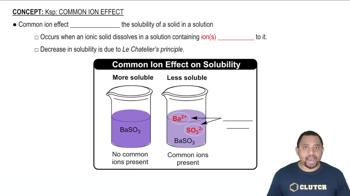Textbook Question
Calculate the molar solubility of calcium hydroxide in a solution buffered at each pH. c. pH = 9
 Verified step by step guidance
Verified step by step guidance



Calculate the molar solubility of calcium hydroxide in a solution buffered at each pH. c. pH = 9
Calculate the solubility (in grams per 1.00⨉102 mL of solution) of magnesium hydroxide in a solution buffered at pH = 10. How does this compare to the solubility of Mg(OH)2 in pure water?
Determine if each compound is more soluble in acidic solution than it is in pure water. Explain. a. BaCO3 b. CuS c. AgCl d. PbI2
Predict whether a precipitate will form if you mix 75.0 mL of a NaOH solution with pOH = 2.58 with 125.0 mL of a 0.018 M MgCl2 solution. Identify the precipitate, if any.